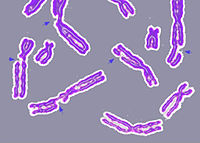
Photo from wikipedia
Recurrent chromosomal translocations often lead to expression of fusion proteins associated with oncogenic transformation. To study translocations and downstream events, genome editing techniques have been developed to generate chromosomal translocations… Click to show full abstract
Recurrent chromosomal translocations often lead to expression of fusion proteins associated with oncogenic transformation. To study translocations and downstream events, genome editing techniques have been developed to generate chromosomal translocations through non-homologous end joining of DNA double-strand breaks introduced at the two participating endogenous loci. However, the frequencies at which these events occur is usually too low to efficiently clone cells carrying the translocation. This article provides a detailed method using CRISPR-Cas9 technology and homology-directed repair to efficiently isolate cells harboring a chromosomal translocation. For an additional level of control, the resulting fusion protein is conditionally expressed to allow early events in oncogenic transformation to be studied. We focus on the generation of the EWSR1-WT1 fusion using human mesenchymal cells, which is associated with the translocation found in desmoplastic small round cell tumors.
Journal Title: Methods
Year Published: 2017
Link to full text (if available)
Share on Social Media: Sign Up to like & get
recommendations!